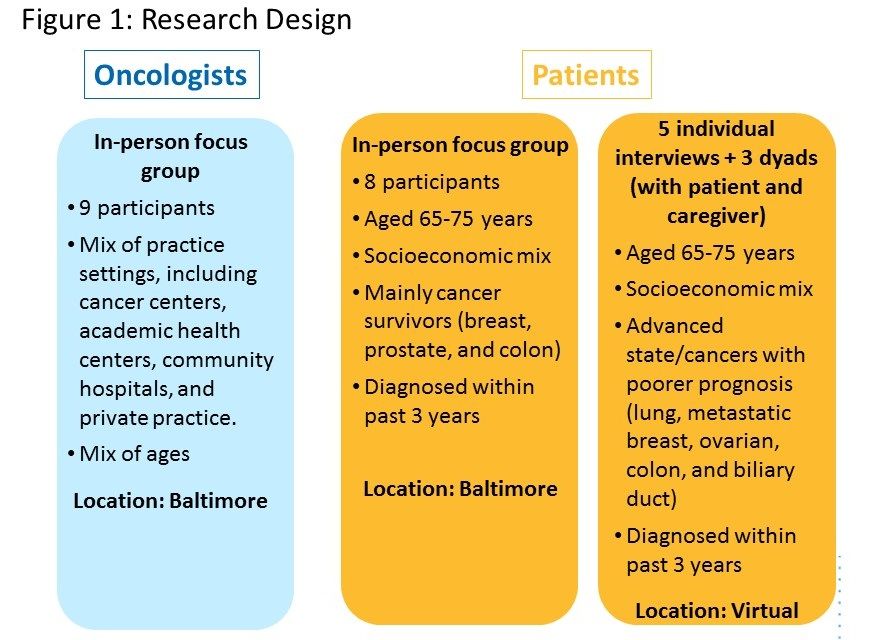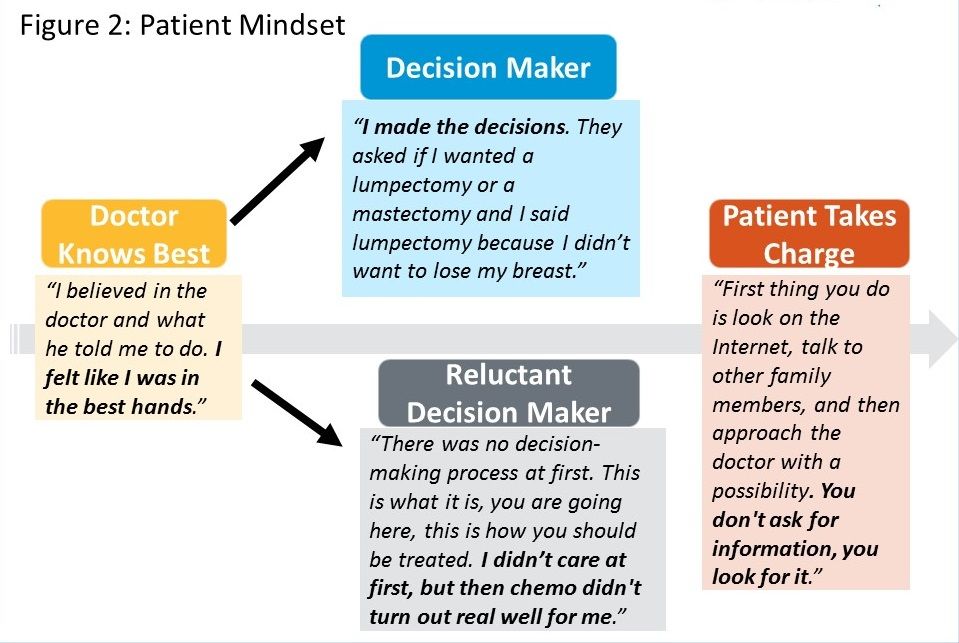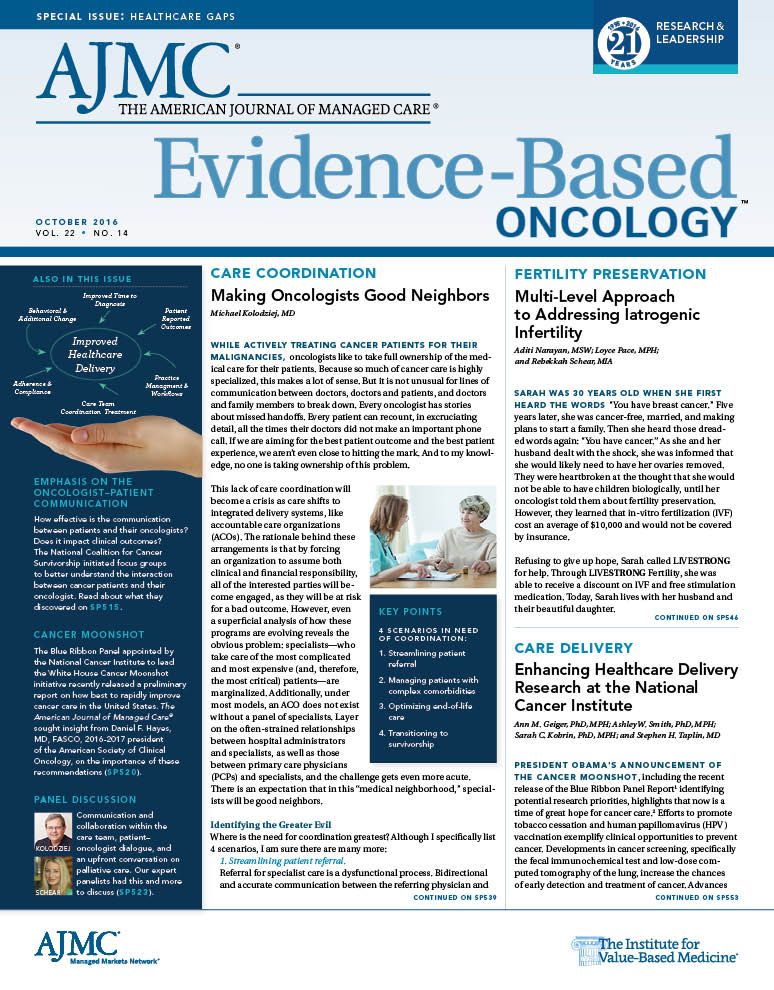- Center on Health Equity & Access
- Clinical
- Health Care Cost
- Health Care Delivery
- Insurance
- Policy
- Technology
- Value-Based Care
Learning About Oncologist—Patient Communications by Speaking Directly With Each
The importance of doctor-patient communication is well established. Focus groups conducted with patients and oncologists help unravel why gaps exists and how to customize strategies for improvement.
The importance of doctor—patient communication in general clinical settings is well established. “Effective doctor–patient communication is a central clinical function in building a therapeutic doctor–patient relationship, which is the heart and art of medicine.”1 The impact of this communication goes even further. “Research has shown that effective patient—physician communication can improve a patient’s health as quantifiably as many drugs—perhaps providing a partial explanation for the powerful placebo effect seen in clinical trials.”2 With the high levels of psychological stress, uncertainty, fear, and sense of helplessness associated with a cancer diagnosis, the National Coalition for Cancer Survivorship (NCCS) sought to learn more about this critical interaction specifically from cancer patients and oncologists.
BACKGROUND
Three decades ago, a cancer experience was viewed differently than it is today. Someone diagnosed with the disease was simply and helplessly referred to as a “cancer victim” and was often treated accordingly. However, for a small group of individuals, many of whom had experienced a cancer journey themselves, the status quo was no longer acceptable. In 1986, this group— including recognized experts on employment and disability law, healthcare consumerism, and psychosocial and behavior­al research—came together to create NCCS. The organization changed the culture in oncology, replacing “cancer victim” with “cancer survivor” and creating the concept of “survivorship.” NCCS defined someone as a “survivor” from the time of diagno­sis and for the balance of life, which is now the norm for the en­tire cancer community, including the National Cancer Institute.
Today, there are an estimated 15.5 million cancer survivors, with projections that nearly 1.7 million additional persons will be di­agnosed with cancer this year alone.3 By 2026, it is estimated that there will be 20.3 million cancer survivors in the United States.3 Add to these figures the caregivers, family members, and friends of a cancer patient, and the number of individuals impacted by cancer is staggering—it affords relevance to the substantial investments in cancer research, primarily focused on treatments. However, with evidence indicating the importance of survi­vorship issues, including quality of life (QOL) during and after cancer treatment, it is critical that more effort and resources be devoted to improving doctor—patient communication, and en­suring shared decision making, so that treatment choices reflect the patient’s goals and values.
NCCS-Initiated Focus Groups
One of the goals at NCCS is ensuring a shared decision-making process between patient and provider that includes a discussion of the specific diagnosis, prognosis, goals of care, treatment op­tions (including the benefits and risks of each option), QOL, and patient preferences. To enhance our understanding of stakehold­er perspectives on these issues and to identify the most effective approaches to improve communication and adoption of shared decision making, NCCS collaborated with Edge Research to con­duct patient—oncologist focus groups. The scope of this research was qualitative in nature, intended to be descriptive rather than predictive. As such, statements and observations made regarding “patients” and “oncologists” in this paper refer only to those who took part in this study.

The research objectives included the following:
• Understand the attitudes, values, beliefs, and behaviors of cancer patients and providers regarding communication about diagnosis, treatment options, and goals.
• Understand the challenges of cancer care planning, including discussions on QOL, side effects, access/cost, and the impact of delivery location.
• Gather recommendations for what would improve pa­tients-provider communication (eg, tools, practice struc­tures, etc).
The oncologists participated in an in-person focus group with 9 participants of different ages and from different practice settings, including cancer centers, academic health centers, community hospitals, and private practice (Figure 1). Each participant works with large populations of Medicare patients.
The patients were split into 2 groups. The first was an in-person group of 8 participants, aged 65 to 75 years, representing a mix of socioeconomic backgrounds; they were primarily cancer survivors who had completed treatment and had been diagnosed within the past 3 years. The second group took part in a series of 8 in-depth interviews conducted virtually—5 with individual patients and 3 dyads with a patient and their caregiver. These patients had advanced cancers with poor prognosis. All focus groups and interviews were conducted in January and February of 2016.
RESEARCH FINDINGS
Patient Mindset
The conversations revealed a range of patient mindsets about the oncologist—patient relationship, falling on a spectrum from little patient involvement to a take-charge approach (Figure 2).
Treatable and early-stage patients fell predominately under the “decision maker” mindset and are an extension of the “doctor knows best” mentality. They want their doctor to steer the ship, but it’s also important for them to feel like they have choices for their treatment options. Patients with advanced cancer and a poorer prognosis, however, had a wider spectrum of mindsets, whether based on personality (the take-charge patient) or on circumstance (the reluctant decision maker who is forced to assume a greater role in their care). To complicate this dynamic further, patients may shift from one mindset to another during their journey due to a variety of factors, including poor treatment and care, recurrence of disease, and fear of death. These mind­sets, and how patients relate to the oncologist—patient relation­ship, must be considered when developing and implementing strategies for improvement.

Not surprisingly, physician mindsets showed a wide degree of variance, as well. Physicians shared that they value good out­comes for their patients, but they take different approaches toward achieving these outcomes. Some were more paternalistic in their interactions (“You can beat them over the head, but they may have very strong opinions about what they want. It’s like being with your kids. Being a parent helps you be a good doc­tor,”), while others saw themselves as more of an interpreter or a guide through a decision-making process (“They are ultimately decision makers, but they [don’t have enough information] to make decisions so we guide them”). One attribute that came through, and this was seen vividly during the discussion regard­ing care planning tools, was that many physicians felt as though they were losing control of how they practice their craft. They cited changes to drug costs, reimbursement, value-based care, use of electronic health records, quality measurement, and a general sense that they were losing autonomy of how they ran their practice or provided care.
With these variations in mindset, in addition to the historical oncologist—patient dynamic, it is no wonder that considerable disconnects in communication continue to exist. To be fair, both patients and oncologists agreed that trust and empathy (estab­lishing a good rapport) were key elements to a beneficial oncol­ogist–patient relationship. However, the similarities ended there, with disagreement on how to establish that trust and empathy. Whereas both groups said they believed in the goal of developing and wanting a partnership, the definitions for each group were highly variable (patient “buys in” to the oncologist’s recommenda­tions vs a true back and forth discussion). Further, the oncologists showed that they inherently believe in the value of good communi­cation with their patients, but again, their definitions of “good” were highly variable and often at odds with patient values (see Table).
In general, patients wanted to feel heard, but many also ex­pressed a desire to feel comforted by the security of having a plan laid out for them. Several admitted that they were more comfortable taking their questions to a different member of the staff (ie, patient advocate, nurse, or social worker).
Shared Decisions and Patient Centricity
When discussing the oncologist—patient relationship, the terms “shared decision making” and “patient-centered care” are widely used, particularly in the patient advocacy community. However, when exploring this terminology with patients and oncologists, we found that understanding and interpretations varied wildly.
Oncologists’ interpretations of the term “shared decision mak­ing” ranged from the need to secure patient buy-in for treatment success to having patients be active or contributing participants in their own care planning. Most saw some form of shared deci­sion making as necessary for treatment, but differed on what this actually meant. A few of the doctors shared that they preferred the term “informed and shared decision making.” Among pa­tients, the definition depended on their mindset. Many of the patients said they wanted to be comforted and given direction in order to arrive at a decision they feel they own; at the very least, most wanted to feel like they were offered a choice.
Patient-centered care is gaining greater attention in the medical community. Yet, the oncologists in the focus group almost unanimously viewed the term as highly politicized and anti-physician. They believe the term provides additional evidence on how bureaucrats dictate physician performance. Oncologists responded negatively, and even resentfully, to the term, which they equated with 24-7 accessibility, a symbol of practice change that they considered unrealistic and unrea­sonable. For patients, while the term was largely unknown, it garnered associations around greater access to support services and good customer service (many equated it with a cancer cen­ter, a relationship with nurse or patient advocate, or a support group). When patients were asked if they had actually expe­rienced receiving patient-centered care, the responses were mixed (ie, “It doesn’t exist!” vs “This is my cancer center”).
The disconnect between doctors and patients around commu­nication and decision making extends to discussions around treatment planning and QOL goals. These are discussions that patients don’t seem to be having with their doctors, resulting in poor communication around needs and expectations for QOL and symptom management.
For example, discussion around palliative care reinforced the common misunderstanding that palliative care is only provided at the end of life. Regardless of the stage, most patients were not familiar with the term and associated it with hospice care—a topic many do not feel ready to discuss. Pain and discomfort, howev­er, were a pervasive part of the patient journey. Indeed, thinking about worst-case scenario/end of life was something many were fearful of, although some patients with more advanced disease were more open to these types of discussions. Patients do not re­member physicians bringing up palliative care or hospice as part of the discussion on treatment, and some patients were frustrated that their doctors avoid the topic. As other surveys have shown, the concept of palliative care is well received when it is explained to patients. Unfortunately, the terminology is the problem.
Although they are not necessarily proactive in their care planning, all participating patients valued being prepared for their visits. Patients admitted they had a hard time remembering information they receive at appointments, and oncologists concurred that the Medicare population was usually less prepared and could only absorb a certain amount of information. As such, patients saw the usefulness of care planning tools in helping them remember and track important information for their care and symptom manage­ment; however, these would need to be tailored to patient needs and preferences. For example, the ability to track symptoms or keep a record of their chemotherapy treatments was especially ap­pealing for patients in treatment (hard to remember during “che­mo fog”), but they found a vast treatment plan too overwhelming. They felt such tools should to be made available by a doctor or nurse in a paper format, as well (“People over 60 [years] need a clipboard”), and should be referenced during appointments.
Conversely, the oncologists resented any additional paperwork, claiming that patients would not use these types of care planning tools, and thus ultimately dismissed their usefulness. One quote from a doctor summed it up: “All this paperwork is going to be left behind. If a patient is interested in this information, they’re going to have it already.”
IMPLICATIONS AND NEXT STEPS
This small study is a step forward in exploring these important issues further via direct interaction with patients and oncologists. We interviewed a range of patients who reinforced that cancer is complicated and it is difficult to design one-size-fits-all strat­egies. Based on individual mindsets, certain subsets of patients are more receptive to tools and strategies to help them manage their care and communicate with their doctors than others. That said, patients who want their doctors to take the lead are not a lost audience and also require various levels of assistance—many of these patients acknowledge the need for help in retaining infor­mation, tracking side effects, and acquiring additional guidance when making decisions.
The Medicare patient mindset appears to be influenced by a vari­ety of factors that merit further exploration, including socioeco­nomic status, care delivery setting, and disease severity. Additional qualitative and quantitative research among Medicare patients across these groups could help further elucidate the types of patient mindsets and yield added insights into finding what tools and strategies are most useful to specific types of patients.
The Impact of Payment and Delivery Reforms
Our study clearly showed that the oncologists felt an increasing loss of control due to a variety of factors, including changes in payment models and care delivery. This is compounded by new pressures from being evaluated on performance metrics. It is in this environment that we must recognize and seek to under­stand the ongoing disconnect between doctor and patient, and more importantly, how best to make improvements through ad­ditional help with soft skills (ie, patient communication). These added pressures also provide some insights on their reactions to care planning tools—one that is easy to use and does not burden their already busy schedules (ie, they will resent filling out more paperwork, and they expect respect and reimbursement for their time). Continuing medical education was not considered a viable option for the oncologists in the focus group.
From the NCCS perspective, what is at stake is far too import­ant not to pursue every possibility. As Travaline et al state, “The physician who can communicate bad news in a direct and com­passionate way will not only help the patient cope, but will also strengthen the therapeutic relationship, so that it endures and further extends the healing process.”2
Additional qualitative and quantitative research with oncologists would identify who is open to education and training around communication and use of tools, in addition to identifying less politicized language that can be used to discuss shared goals. The results from this small focus group already suggest that there are differences in oncologists’ attitudes and values by age, years in practice, and practice settings. These questions need to be explored further with a larger sample of oncologists.
There was some consensus among participants that Medicare patients and oncologists are not always best equipped to talk to each other. Future research projects could delve into increasing the engagement of intermediaries such as nurse practitioners, patient advocates, and other mid-level providers, along with informal caregivers (family members and friends). Although caregiver perceptions were preliminarily explored through the dyad approach, it would be helpful to talk to them as a separate audience who may not only have a different mindset, but be more receptive to tools and strategies. Also, given their key role as patient advocates and intermediaries between patients and oncologists, it would also be important to explore questions around improving communication and patient-centered care with nurses, social workers, patient navigators, etc. Looking to those outside of the traditional oncologist—patient relationship may offer additional solutions for improving shared decision making and, ultimately, patient care.
Dan Weber, MPM, is the director of communications, National Coalition for Cancer Survivorship.
Shelley Fuld Nasso, MPP, is the chief executive officer, National Coalition for Cancer Survivorship.
Address for correspondence
Dan Weber, MPM
8455 Colesville Rd., Suite 930
Silver Spring, MD 20910
E-mail: dweber@canceradvovacy.org
Funding source
The National Coalition for Cancer Survivorship received an unrestricted educational grant from Pfizer to conduct this research.
References
1. Ha JF, Longnecker N. Doctor-patient communication: a review. Ochsner J. 2010; Spring;10(1):38-43.
2. Travaline J, Ruchinskas R, D’Alonzo GE Jr. Patient-physician communication: why and how. J Am Osteopath Assoc. 2005;105(1):13-18.
3. Cancer treatment & survivorship facts & figures: 2016-2017. American Cancer Society website. http://www.cancer.org/acs/groups/content/@research/documents/document/acspc-048074.pdf. Published 2016. Accessed September 13, 2016.

Trends in Hospital Pricing for Vulnerable Emergency Department Users, 2021-2023
December 4th 2025Self-pay emergency department prices rose significantly from 2021 to 2023, especially at for-profit and system-affiliated hospitals, highlighting growing affordability challenges for uninsured and underinsured patients.
Read More
Integrated Care for Chronic Conditions: A Randomized Care Management Trial
December 3rd 2025The authors sought to understand the differential impact of payer-led community-based care management approaches on stakeholder-oriented outcomes for publicly insured adults with multiple chronic conditions.
Read More

